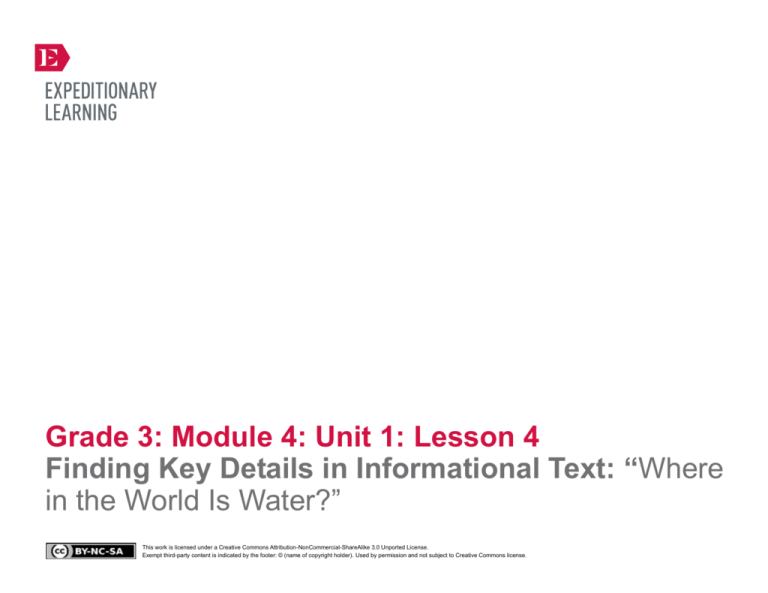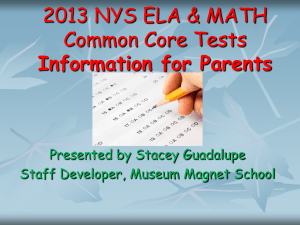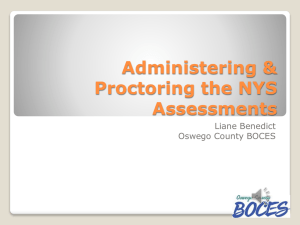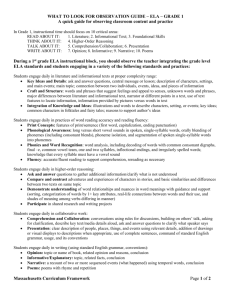
Grade 3: Module 4: Unit 1: Lesson 4
Finding Key Details in Informational Text: “Where
in the World Is Water?”
This work is licensed under a Creative Commons Attribution-NonCommercial-ShareAlike 3.0 Unported License.
Exempt third-party content is indicated by the footer: © (name of copyright holder). Used by permission and not subject to Creative Commons license.
GRADE 3: MODULE 4: UNIT 1: LESSON 4
Finding Key Details in Informational Text:
“Where in the World Is Water?”
Long-Term Targets Addressed (Based on NYSP12 ELA CCLS)
I can answer questions using specific details from informational text. (RI.3.1)
I can retell key ideas from an informational text. (3.2)
I can determine the meaning of unknown words in informational text. (RI.3.4)
Supporting Learning Targets
Ongoing Assessment
• I can answer questions about “Where in the World Is Water?”
• I can identify key details about water sources from the text “Where in the World Is Water?”
• Where in the World Is Water: Key Details recording
form
• I can determine the meaning of unknown words using context clues.
• Vocabulary recording form
Copyright © 2013 by Expeditionary Learning, New York, NY. All Rights Reserved.
NYS Common Core ELA Curriculum • G3:M4:U1:L4 • June 2014 •
1
GRADE 3: MODULE 4: UNIT 1: LESSON 4
Finding Key Details in Informational Text:
“Where in the World Is Water?”
Agenda
Teaching Notes
1. Opening
• Throughout this unit, students will be asked to read informational text with greater independence. In
this lesson, they first grapple with the text on their own but with a partner nearby for support as needed.
You circulate to observe and support, reading aloud only if students need that additional scaffold.
A. Engaging the Reader: Reviewing Simple,
Compound, and Complex Sentences Homework (5
minutes)
B. Unpacking the Learning Targets (5 minutes)
2. Work Time
A. Finding Key Details about Water Sources (30
minutes)
B. Using Context Clues to Determine Word Meaning
(15 minutes)
3. Closing and Assessment
A. Vocabulary Share (5 minutes)
• After students read, they discuss with their partner and then again work independently to find the key
details of water sources. If students struggle, bring them back together for a “catch” and provide
modeling according to the support they might need.
• During Part B of Work Time, students work with vocabulary in the text. Note the simple studentfriendly distinction between domain-specific science vocabulary (in this case, “words about water”) and
academic vocabulary (words students “might see in other books and that are important to know”). Given
the emphasis on academic vocabulary in the CCLS, it is important that students continue to focus on
building their “word power.” Consider harkening back to the early work in Module 1 and the importance
of building one’s vocabulary as one “reading superpower.”
• Post: Learning targets.
4. Homework
A. “Where in the World is Water” homework sheet
Copyright © 2013 by Expeditionary Learning, New York, NY. All Rights Reserved.
NYS Common Core ELA Curriculum • G3:M4:U1:L4 • June 2014 •
2
GRADE 3: MODULE 4: UNIT 1: LESSON 4
Finding Key Details in Informational Text:
“Where in the World Is Water?”
Lesson Vocabulary
Materials
surface, continually, portion,
compresses
• Simple, Compound, and Complex Sentences homework (from Lesson 3)
• One Well: The Story of Water on Earth (one copy for display)
• “Where in the World Is Water?” article (one per student)
• Clipboards or another hard surface for students’ texts
• Where in the World Is Water?: Key Details recording form (one per student)
• Vocabulary recording form (one per student)
• Equity sticks
• Answering Questions about “Where in the World is Water?” homework sheet
Opening
Meeting Students’ Needs
A. Engaging the Reader: Reviewing Simple, Compound, and Complex Sentences Homework (5 minutes)
• Gather students in the whole group area. Return their Simple, Compound, and Complex Sentences homework from
the previous day. Ask students to form triads. Tell them that they are now going to review their homework together. As
students work, circulate and listen to their sentences. Note anyone who might be confused and offer clarification. Give
students about 5 minutes to share their homework. Then, gather their homework sheets for you to review later.
• Provide nonlinguistic symbols
above important words in the
learning targets (e.g., a question
mark above the word question) to
help students understand the
targets.
B. Unpacking the Learning Targets (5 minutes)
• Invite individual students to read the targets aloud. Answer any clarifying questions about the language of the targets. These
targets should be familiar to students.
• Ask:
* “How do these targets help you become stronger readers?”
• Give students time to think and talk together. Pull equity sticks for responses to share with the whole group. Reinforce the
idea that the targets represent what readers do when they read text so that they can learn more and build their own reading
power. Explain that the more they practice with these targets, the more they learn.
Copyright © 2013 by Expeditionary Learning, New York, NY. All Rights Reserved.
NYS Common Core ELA Curriculum • G3:M4:U1:L4 • June 2014 •
3
GRADE 3: MODULE 4: UNIT 1: LESSON 4
Finding Key Details in Informational Text:
“Where in the World Is Water?”
Work Time
Meeting Students’ Needs
A. Finding Key Details about Water Sources (25 minutes)
• Display page 7 from One Well: The Story of Water on Earth.
• Use thoughtful pairings of students.
ELL language acquisition is
facilitated by interacting with native
speakers of English who provide
models of language.
• Connect to the conversation students had about what surprised them in the last lesson. Read aloud the water sources that
are listed in “Where in the World Is Water?” (oceans, glaciers, etc.).
• Explain to students that today they are going to learn more about where water comes from by reading about each of these
water sources.
• Tell students that first they are going to read this text together with a partner, just as they did when reading Peter Pan.
Remind them that their job is to read the text on their own but check in with their partner if they get stuck on a word or have
a question.
• Distribute the text “Where in the World Is Water?” and hard surfaces like clipboards. Display a copy of the text.
Explain to students that if they find a word they are uncertain about, they should circle it.
• Tell them they will have about 10 minutes to read independently. (Keep students in the whole group area as they read
independently, so you can listen in more easily.)
• As students read, circulate to observe and support partnerships as needed. For those who need additional help, read aloud as
they read along in their heads.
• After about 10 minutes, put students together in groups of four. Ask:
* “What did you find out?”
* “Where in the world is water?”
• Give students a few minutes to talk together about what they read.
• Refocus students whole group. Ask:
• Struggling learners benefit from
chunking the text into smaller
pieces at a time. Focus their
attention on one water source first
and ask them to complete the
recording form about that one water
source (e.g., oceans). If they are
then ready to move on to the next
paragraph, they can.
• Be strategic when placing students
in their groups of four. If there is a
pair of struggling learners, place
them in a stronger partnership. This
allows the struggling learner
partnership to share the key details
from the smaller chunk they read
and the other partnership to share
something from the rest of the text.
* “When the text says: ‘97 percent of our water is found in the oceans,’ what do you think that means? Think about that
number for a minute and then talk to your group about what that means.”
• Give them a minute to think, then talk together.
• Invite one or two students to share. Guide students to clarity about 97 percent; draw a bar graph representing 97 out of 100
on the board or on the article itself to show it visually. If students are still unclear, draw the number 10 percent on the bar
graph for comparison. Before students record key details, they should have a concept of how the text is giving information
through numbers.
Copyright © 2013 by Expeditionary Learning, New York, NY. All Rights Reserved.
NYS Common Core ELA Curriculum • G3:M4:U1:L4 • June 2014 •
4
GRADE 3: MODULE 4: UNIT 1: LESSON 4
Finding Key Details in Informational Text:
“Where in the World Is Water?”
Meeting Students’ Needs
Work Time (continued)
• Display the Where in the World Is Water: Key Details recording form. Invite a few students to share something
they talked about. Probe to get them to share key details. Restate what they shared as a key detail about a certain water
source. For example, if a student shares: “We talked about the Pacific Ocean,” ask students to tell you something specific
about the Pacific Ocean. They might say: “It is the largest ocean.” Write that key detail on the recording form in the Ocean
box.
• Tell students that now they are going to go back into the text and find the key details about each one of the water sources
they read about. Encourage them to write down at least two key details about each water source.
• Encourage partners who read together earlier to continue working together. As students work, circulate and support them
with specific questions when conferring. For example:
* “Tell me what you learned about lakes in this reading.…So, that is an important key detail. Write that on your recording
form.”
• Give students 10 minutes to complete their recording form on their own.
Copyright © 2013 by Expeditionary Learning, New York, NY. All Rights Reserved.
NYS Common Core ELA Curriculum • G3:M4:U1:L4 • June 2014 •
5
GRADE 3: MODULE 4: UNIT 1: LESSON 4
Finding Key Details in Informational Text:
“Where in the World Is Water?”
Meeting Students’ Needs
Work Time (continued)
B. Using Context Clues to Determine Word Meaning (15 minutes)
• Gather students back in the whole group area with their texts and recording forms. Congratulate them on their hard work as
readers. Give them specific praise based on what you noticed as they were reading. For example, give students specific praise
about finding key details in the text: “I noticed that ____ and ____ were going back into the text to use the specific words
and phrases about glaciers. That’s using evidence from the text and helping you be a strong reader.”
• Display the Vocabulary recording form. Explain that when you were reading the text, you found some words that you
thought were particularly tricky. Explain that they are going to learn a lot of words about water, but there are also words in
the text that they might see in other books that are important to know.
• If needed, use the first word as guided practice. Invite students to read the sentence aloud and then talk in pairs about the
meaning of the word. Guide them to the right definition and write it on the recording form. Be sure students notice that on
the recording form, there are two spaces for them to find their own words. Tell them that it’s fine if they don’t have words,
but they should be sure to complete the word already given on the form.
• Release students to work on their own. Ask them to continue working with their partner for support.
• Give students 15 minutes to complete the Vocabulary recording form. As they are working, circulate to observe and support
as needed. If students are unsure of a word, read the sentence aloud and do a brief think-aloud to model how to use context
clues to figure out the word.
• A think-aloud could sound like: “Hmm, continually. That sounds like a word I know: continue. And when I read the
sentence, it talks about the fact that lakes need to have water continually flowing into them. That makes me think about how
lakes always need water flowing: that it should continue or keep going.”
Copyright © 2013 by Expeditionary Learning, New York, NY. All Rights Reserved.
NYS Common Core ELA Curriculum • G3:M4:U1:L4 • June 2014 •
6
GRADE 3: MODULE 4: UNIT 1: LESSON 4
Finding Key Details in Informational Text:
“Where in the World Is Water?”
Closing and Assessment
Meeting Students’ Needs
A. Vocabulary Share (5 minutes)
• Gather students back in the circle. Put them in groups of three to share the words they found on their recording form.
• Listen first to the struggling learners
as they share their words to ensure
they have the meaning.
• After a few minutes, use equity sticks to invite students to share words they found and what the meaning is; clear up
misconceptions as needed.
Meeting Students’ Needs
Homework
• Reread “Where in the World Is Water?” to someone at home. Then answer the questions on your Answering Questions
about “Where in the World is Water” homework sheet.
Note: Review students’ Vocabulary recording forms. Ensure that they don’t have misconceptions about the word. Review
students’ Where in the World Is Water: Key Details recording form.
Copyright © 2013 by Expeditionary Learning, New York, NY. All Rights Reserved.
NYS Common Core ELA Curriculum • G3:M4:U1:L4 • June 2014 •
7
Grade 3: Module 4: Unit 1: Lesson 4
Supporting Materials
This work is licensed under a Creative Commons Attribution-NonCommercial-ShareAlike 3.0 Unported License.
Exempt third-party content is indicated by the footer: © (name of copyright holder). Used by permission and not subject to Creative Commons license.
GRADE 3: MODULE 4: UNIT 1: LESSON 4
Where in the World Is Water?
When you look at a globe or a map of the world, there is a lot of blue. The blue on a map or globe
represents a water form on the surface of the earth; it could be a lake, a river, an ocean, or a sea. There
are many different sources of water in the world, but only a small part of that water is drinkable.
OCEANS
Ninety-seven percent of our water is found in the oceans. Across the world, there are five oceans. Even
though 97 percent of the water is found in the oceans, we can’t drink ocean water because it is
saltwater. The oceans are still mysterious to scientists because there is so much to explore. Scientists
are only now beginning to explore what lives deep in the ocean.
Pacific Ocean: The name “Pacific” comes from the Latin word “pacificus,” which means peaceful.
The Pacific Ocean covers twice as much space as any other ocean. If you pushed all the land on earth
together, the Pacific Ocean would still be bigger. Not only is the Pacific Ocean the biggest, but it is also
the deepest ocean in the world. The Mariana Trench, a narrow canyon, is more than 36,000 feet down
from the surface of the ocean.
Copyright © 2013 by Expeditionary Learning, New York, NY. All Rights Reserved.
NYS Common Core ELA Curriculum • G3:M4:U1:L4 • June 2014 •
9
GRADE 3: MODULE 4: UNIT 1: LESSON 4
Where in the World Is Water?
LAKES
Lakes form when water from snowmelt, rivers, or streams finds its way into a basin (bowl shape) that
has formed on the surface of the earth. Lakes need to have water continually flowing into them, or
they will dry up.
Lake Superior: Lake Superior is one of the five Great Lakes of North America. It contains 10 percent
of all of the earth’s surface freshwater. Lake Superior is like a mini freshwater ocean. It is the coldest
and deepest of the Great Lakes. It is also one of the cleanest freshwater lakes. Lake Superior is so big
that it even influences the weather around it.
RIVERS
Over millions of years, moving water carved paths in the earth, forming rivers. Rivers are one of the
world’s freshwater sources. The water in rivers comes from melting snow high in the mountains.
Sometimes it comes from water that is underground and bubbles up to the surface. Rivers have many
sizes and shapes. Some have water that flows slowly and gradually. In others, water speeds down,
crashing over the rocky earth. Eventually, the water from all rivers finds its way to an ocean.
Nile River: The world’s longest river is the Nile on the continent of Africa. It is more than 4,000
miles long. The Nile River goes through the countries of Kenya, Eritrea, Congo, Burundi, Uganda,
Tanzania, Rwanda, Egypt, Sudan, and Ethiopia. Eventually, it finds its way to the Mediterranean Sea.
The Nile River is very important to the people who live by it. The river provides water to drink and
rich soil for food to grow. Without the Nile, the Egyptian civilization wouldn’t have grown.
Copyright © 2013 by Expeditionary Learning, New York, NY. All Rights Reserved.
NYS Common Core ELA Curriculum • G3:M4:U1:L4 • June 2014 •
10
GRADE 3: MODULE 4: UNIT 1: LESSON 4
Where in the World Is Water?
GLACIERS
Glaciers form when snow doesn’t melt and piles up. Snow falls on top of old snow, creating thick
layers. The snow is heavy. Over time, it compresses to form layers of glacial ice. Glaciers make up 2
percent of earth’s freshwater. Glaciers also have dirt and rocks mixed in with the ice and snow. They
are constantly moving from the pressure of the ice as it melts and freezes again. Icebergs are created
when chunks of a glacier crack off and fall into the water. One of the biggest glaciers in North America
is Hubbard Glacier in the state of Alaska. It rises 300 feet above the water and is almost 6 miles long.
Only one-eighth of the glacier is visible. The rest is hidden under the water. Only the tip, or top, of an
iceberg can be seen above the water line; the rest of it lies beneath the surface. Sometimes people use
the phrase “tip of the iceberg” to mean that there is much more to the story than it seems at first. This
expression comes from the fact that only a small portion of icebergs are seen.
GROUNDWATER
Not all of our water is on the surface of the earth. Some of it is underground. Water will find its way
into the tiniest of cracks in rocks. The soil soaks up water like a sponge. Our soil holds a lot of the
water on earth. Sometimes that water is deep in the ground in aquifers. An aquifer is sort of like an
underground lake; the water is stored in between layers of rock, deep in the ground. People drill holes
through the rock to access the water underground. This is an important source of drinking water for
the world’s people.
730 L
Written by Expeditionary Learning for Instructional Purposes
Sources:
Beth Geiger, Sally Ride Science: Clean Water (New York: Roaring Brook Press, 2008), ISBN: 978-1-59643-577-3.
Trudi Strain Trueit, The Water Cycle (New York: F. Watts, 2002), ISBN: 978-0-53111-972-3.
http://www.onegeology.org
http://www.kidsgeo.com/
Copyright © 2013 by Expeditionary Learning, New York, NY. All Rights Reserved.
NYS Common Core ELA Curriculum • G3:M4:U1:L4 • June 2014 •
11
GRADE 3: MODULE 4: UNIT 1: LESSON 4
Oceans
Rivers
Lakes
Glaciers
Groundwater
“Where in the World Is Water?”: Key Details
Copyright © 2013 by Expeditionary Learning, New York, NY. All Rights Reserved.
NYS Common Core ELA Curriculum • G3:M4:U1:L4 • June 2014 •
12
GRADE 3: MODULE 4: UNIT 1: LESSON 4
Vocabulary Recording Form
I can determine the meaning of unknown words using context clues.
Word
What I think it means
How I figured it out
Surface
The blue on a map or globe
represents a water form on the
surface of the earth; it could be
a lake, a river, an ocean, or a
sea.
Influences
Lake Superior is so big that it
even influences the weather
around it.
Portion
This expression comes from the
fact that only a small portion
of icebergs are seen.
Compresses
Snow falls on top of old snow,
creating thick layers. The snow
is heavy. Over time, it
compresses to form layers of
glacial ice.
Copyright © 2013 by Expeditionary Learning, New York, NY. All Rights Reserved.
NYS Common Core ELA Curriculum • G3:M4:U1:L4 • June 2014 •
13
GRADE 3: MODULE 4: UNIT 1: LESSON 4
Vocabulary Recording Form
Word
What I think it means
How I figured it out
My own word:
My own word:
Copyright © 2013 by Expeditionary Learning, New York, NY. All Rights Reserved.
NYS Common Core ELA Curriculum • G3:M4:U1:L4 • June 2014 •
14
GRADE 3: MODULE 4: UNIT 1: LESSON 4
Answering Questions about “Where in the World Is Water?”
Homework
1. Describe the Pacific Ocean. Use specific details from the text to support your answer.
2. Why do you think Lake Superior is an important water source? Use specific details to support your
answer.
3. The text says: “The Nile River is very important to the people who live by it.” Why do you think the
Nile River would be important for people living next to it?
Copyright © 2013 by Expeditionary Learning, New York, NY. All Rights Reserved.
NYS Common Core ELA Curriculum • G3:M4:U1:L4 • June 2014 •
15
GRADE 3: MODULE 4: UNIT 1: LESSON 4
Answering Questions about “Where in the World Is Water?”
Homework
4. Explain how glaciers are formed. Use specific details from the text to support your answer.
Copyright © 2013 by Expeditionary Learning, New York, NY. All Rights Reserved.
NYS Common Core ELA Curriculum • G3:M4:U1:L4 • June 2014 •
16







